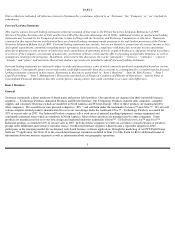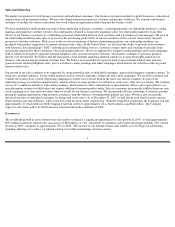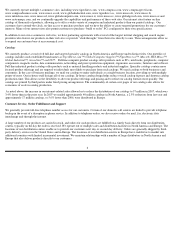Circuit City 2007 Annual Report Download - page 15
Download and view the complete annual report
Please find page 15 of the 2007 Circuit City annual report below. You can navigate through the pages in the report by either clicking on the pages listed below, or by using the keyword search tool below to find specific information within the annual report.
• Sales to individual consumers exposes us to credit card fraud, which could adversely affect our business.
Failure to adequately control fraudulent credit card transactions could increase our expenses. Increased sales to individual
consumers, which are more likely to be paid for using a credit card, increases our exposure to fraud. We employ technology
solutions to help us detect the fraudulent use of credit card information. However, if we are unable to detect or control credit card
fraud, we may suffer losses as a result of orders placed with fraudulent credit card data, which could adversely affect our business.
• We are exposed to inventory risks.
A substantial portion of our inventory is subject to risk due to technological change and changes in market demand for particular
products. If we fail to manage our inventory of older products we may have excess or obsolete inventory. We may have limited
rights to return purchases to certain suppliers and we may not be able to obtain price protection on these items. The elimination of
purchase return privileges and lack of availability of price protection could lower our gross margin or result in inventory write-
downs.
We also take advantage of attractive product pricing by making opportunistic bulk inventory purchases; any resulting excess and/or
obsolete inventory that we are not able to re-sell could have an adverse impact on our results of operations. Any inability to make
such bulk inventory purchases may significantly impact our sales and profitability.
• Our income tax rate and the value of our deferred tax assets are subject to change.
Changes in our income tax expense due to changes in the mix of U.S. and non-U.S. revenues and profitability, changes in tax rates
or exposure to additional income tax liabilities could affect our profitability. We are subject to income taxes in the United States and
various foreign jurisdictions. Our effective tax rate could be adversely affected by changes in the mix of earnings in countries with
differing statutory tax rates, changes in the valuation of deferred tax assets and liabilities, changes in tax laws or by material audit
assessments. The carrying value of our deferred tax assets, which are primarily in the United States and the United Kingdom, is
dependent on our ability to generate future taxable income in those jurisdictions. In addition, the amount of income taxes we pay is
subject to ongoing audits in various jurisdictions and a material assessment by a tax authority could affect our profitability.
• Our reliance on information and communications technology requires significant expenditures and entails risk.
We rely on a variety of information and telecommunications systems in our operations. Our success is dependent in large part on the
accuracy and proper use of our information systems, including our telecommunications systems. To manage our growth, we
continually evaluate the adequacy of our existing systems and procedures. We anticipate that we will regularly need to make capital
expenditures to upgrade and modify our management information systems, including software and hardware, as we grow and the
needs of our business change. In particular, our financial systems are disparate and will likely be replaced during the coming years.
The occurrence of a significant system failure, electrical or telecommunications outages or our failure to expand or successfully
implement new systems could have a material adverse effect on our results of operations.
Our information systems networks, including our web sites, and applications could be adversely affected by viruses or worms and
may be vulnerable to malicious acts such as hacking. Although we take preventive measures, these procedures may not be sufficient
to avoid harm to our operations, which could have an adverse effect on our results of operations.
13
























